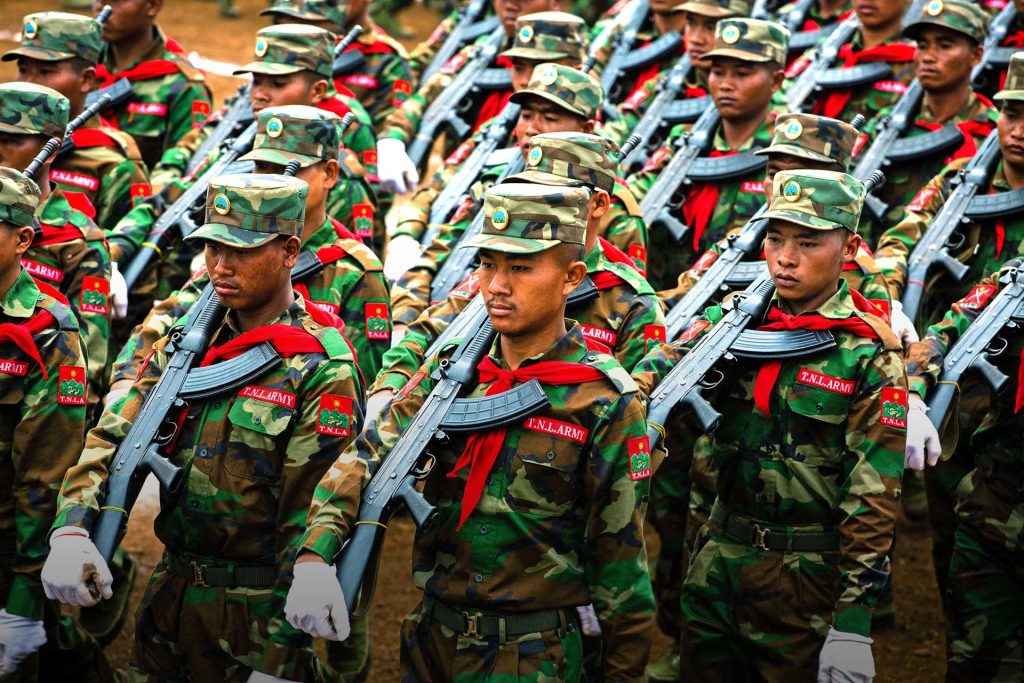Insight Email Vol-2 No. 4
This ISP Insight Email Vol.2. No.4 (English version) is published on March 21, 2024 as a translation of the original Burmese version published on March 15, 2024.
EDITOR’S NOTE
This week ISP-Myanmar presents another review in our series on emerging new generation leaders from Ethnic Armed Organizations (EAOs) and the Spring Revolution movement, framed under the theme “The Rise of Princelings.” With the generational shifts, there comes an extraordinary change in perspectives. The younger generation of leaders is naturally more inclined to pursue new ideas and take risks rather than sticking to the status quo. Their conviction and determination have only intensified as they witness the political fruits of their endeavors. ISP-Myanmar has previously compared this phenomenon with the pride of “Princelings.”
Our previous issue, “The Rise of the Princelings -1,” introduced fresh faces in the Wa leadership (UWSP/UWSA). This week’s sequel introduces the leadership of the Palaung State Liberation Front (PSLF) and its armed wing, the Ta’ang National Liberation Army (TNLA), and their emphasis on institutions. The TNLA has seized control of several cities following Operation 1027 and their priority has now shifted to implementing administrative institutions and systems. While outcomes remain uncertain, youth leadership’s innovative thinking and fresh perspectives are poised to steer politics, economy, and other social spheres along trajectories distinct from those led by older generations. The rise of the new Ta’ang generational leadership diverges from the Wa, who traditionally inherit the legacy of previous generations. Ta’ang new leaders forged their own paths, distinct from direct lineage ties, which in Burmese culture called “Ngattapa Min,” signifying a king unrelated by bloodline to royal predecessors. In future ISP Insight Emails, ISP-Myanmar will feature the Rakhine, Karenni, and other “Ngattapa Min” that emerged during the Spring Revolution.
The Trends to Watch section of this week’s ISP Insight Email examines developments in the effort to eradicate the Kyar Phyant cross-border crime syndicates. Then, our What ISP is Reading section delves into the foreign policy of Myanmar’s most powerful neighbor, China.
KEY TAKEAWAY
The Rise of Princelings – 2
An Upturn of Ta’ang’s Non-Royal Leadership (Ngattapa Min)
After passing through difficult and downgraded times with determination not to go down against all tides, the youth’s self-paved journey now results in evident success.
Under the theme “The Rise of Princelings,” ISP-Myanmar is presenting a series of analytical articles on the new generation of leaders emerging in Ethnic Armed Organizations (EAOs). This week introduces an analysis of the new leaders of Ta’ang (Palaung) and their vision. The first in the series, “The Rise of Princelings-1,” already introduced an analysis of the emergence of new leadership in the Wa regions. In comparison, the new leaders of Ta’ang (Palaung) have walked a different path to those of the Wa to get to where they currently are. The current Wa leaders are mostly successors by lineage to their predecessors. In contrast, the emerging Ta’ang (Palaung) leaders have forged mainly their own paths, akin to what Myanmar history refers to as “Ngattapa Min1,” which literally means a king unrelated by bloodline to royal predecessors. Similarly, the concept of Ngattapa Min extends to the youth leadership in Rakhine, Karen, and the broader Spring Revolution, where young leaders are carving out their own unique trajectories. These themes will be explored further in future ISP Insight Emails.
The Palaung State Liberation Front (PSLF/TNLA) gained the upper hand following Operation 1027, resulting in sizable territory gains after securing control of seven cities. Such a victory has never been seen in the 50-year-long history of the Ta’ang (Palaung) national movement. The current outcome contrasts starkly with the Palaung national movement of the past, also indicating a difference from the leadership from previous generations. A systematic institution, spearheaded by young adults, is evidently taking shape, aiming to establish a new “Nation/State” characterized by effective leadership, robust institutions, and well-defined systems.
The Ta’ang (Palaung) revolution started in 1963 and has progressed through various stages across different eras in modern Myanmar history. In 1976, the Palaung National Front (PNF) transitioned into the Palaung State Liberation Organization/Palaung State Liberation Army (PSLO/PSLA), concurrently becoming members of the National Democratic Force (NDF). Afterward, in 1991, a ceasefire agreement was signed with the then-military junta led by the State Law and Order Restoration Council (SLORC). However, internal divisions emerged between factions supporting and opposing the ceasefire. In 1992, those who remained in Manerplaw on the Myanmar-Thailand border formed the Palaung State Liberation Front (PSLF), which maintained ties with the NDF and participated in the first conference of the Democratic Alliance of Burma (DAB). At those times, a few PSLF youth leaders continued their revolutionary pursuits while passing through difficult and downgraded times with determination not to go down against all tides. The early days of the PSLF were limited to providing political awareness training and educational support for Ta’ang youth. The TNLA, the armed faction of PSLF, began preparations for its formation only in 2007 and officially came into existence in 2009.
Beginning of TNLA: 42 Comrades and 22 Rifles
The Ta'ang National Liberation Army (TNLA), the armed wing of the Palaung State Liberation Front (PSLF), was formed by recruiting former commanders from PSLO/PSLA and youth after the third conference of the PSLF in 2009. In December 2011, 42 Ta'ang (Palaung) youths completed military training from the Kachin Independence Army (KIA) and initiated their revolt with 22 rifles, heading towards Ruili River in northern Shan State. By January 2012, they had resettled in the Ta'ang (Palaung) region. By 2013, the group had expanded to about 500 troops, and in 2023, little more than a decade since inception, the TNLA had transformed into an EAO with a force of tens of thousands of troops.
The PSLF/TNLA, comprising experienced core members and youthful newcomers, maintains the legacy of engaging in alliances. Previously, they allied with the National Democratic Front (NDF) and the Democratic Alliance of Burma (DAB). Additionally, in 2011, the TNLA joined the United Nationalities Federal Council (UNFC), a coalition of 11 ethnic armed groups, including the Karen National Union (KNU), formed under the leadership of the Kachin Independence Organization (KIO). After resigning from the UNFC in 2016, the PSLF/TNLA became a member of the Northern Alliance, which comprises the Kachin Independence Army (KIA), Arakan Army (AA), and Myanmar National Democratic Alliance Army (MNDAA). In 2017, along with the Northern Alliance, they also became members of the Federal Political Negotiation and Consultative Committee (FPNCC) led by the Wa. Since Operation 1027, the TNLA has continued its alliance with the Three Brotherhood Alliance (3BHA), formed with the MNDAA and AA in June 2019.
On the other hand, the PSLO/PSLA (led by Aik Mong), whose territory was designated as Northern Shan Special Region-7, forcedly disarmed themselves and surrendered to the State Peace and Development Council (SPDC) on April 29, 2005. Mai Aik Kaw detailed in the Ta’ang (Palaung) National History book, published in 2017, that Maj. Gen. Myint Hlaing, the Commander of the Northeastern Regional Military Headquarters under the junta, pressured the PSLO to disarm. The effectiveness of the pressure was due to the PSLO facing dwindling popular support and financial constraints, compelling them to yield to the junta’s demands. The History book also states that PSLO was threatened with consequences akin to those experienced by Li Yamen and Mong Sala from Monekoe if they refused to surrender their arms2. Consequently, the PSLO/PSLA, estimated to have a force of 300-500 at the time, decided to surrender to the junta. Aik Mong, Chairman of PSLO, later became Chairman of a legal Ta’ang National Party (TNP) as well as becoming an elected member of the Myanmar parliament in the 2010 general election. Aik Mong was also bestowed with the honorary title Wunna Kyaw Htin by the State Administration Council (SAC).However, the TNP was arbitrarily dissolved by the SAC in 2023, along with many other political parties.
The current top leadership of the PSLF/TNLA is composed of former fighters who have harbored resentment since the PSLO surrendered to the junta. The TNLA’s Central Executive Committee is composed of 11 members, with four in their 50s and the remaining members all younger. The next layer down, the Central Committee, has 27 members, which includes all Central Executive Committee members. While lacking female representation at the executive level, the Central Committee features two female Majors. The current young leadership possesses experience, actively initiates, fosters innovation, and demonstrates agility. These attributes should be considered in comparison not only with the SAC but also with organizations with a long history, such as the Shan State Progress Party (SSPP/SSA), the Restoration Council of Shan State (RCSS/SSA), the Kachin Independence Organization (KIO/KIA) and the Karen National Union (KNU). As mentioned in “The Rise of Princelings – 1” the younger generation of leadership is more inclined to innovate, unlike the older generation that leans toward the status quo and is risk-avert.
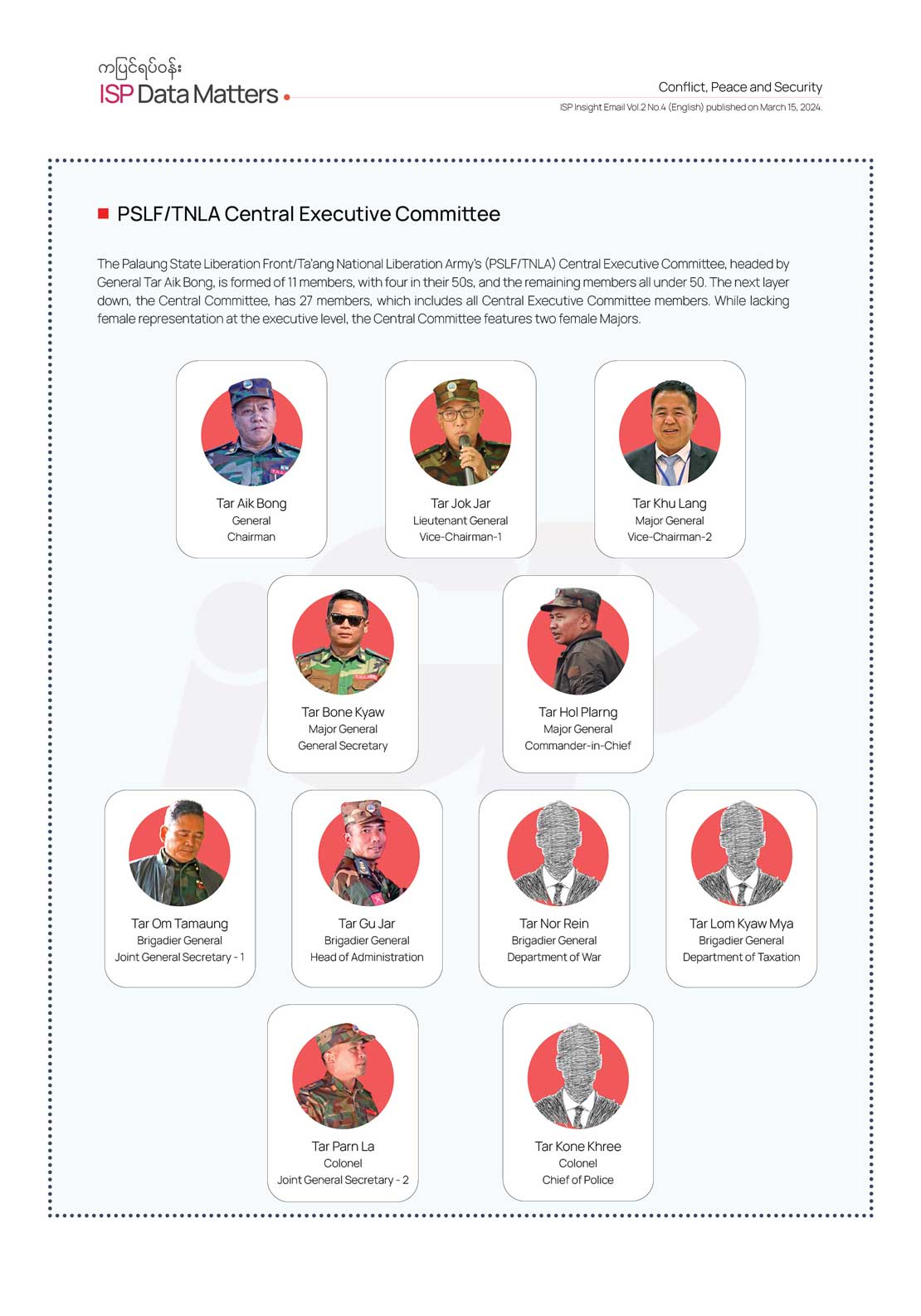
The Chairman of the PSLF/TNLA, Gen. Tar Aik Bong, is a middle-aged leader. He was previously known as a youth leader “Mai Aik Phone,” when he remained stationed at the DAB joint headquarters on the Myanmar-Thailand border of Manerplaw during the PSLO ceasefire, where he struggled to ensure the organization’s survival and the continuity of the revolution. To realize his dreams, he returned to the Ta’ang (Palaung) region from the Myanmar-Thailand border around 2007 to reignite the revolution. Vice-chairman-1, Lt. Gen. Tar Jok Jar, formerly served as the private secretary of the former Chairman, Aik Mong,and as a signal officer. Witnessing the surrender of the PSLO in 2005 firsthand, he has since harbored deep resentment towards the junta. The Vice-Chairman-2, Maj. Gen. Tar Khu Lang is renowned for his extensive experience, maturity, friendly demeanor, and strong external relations. He is also mostly associating with youth. Maj. Gen. Tar Bone Kyaw, the General Secretary and the brain of the TNLA, previously led a Ta’ang youth organization and attended a year-long Foreign Affairs course by the National Council Union of Burma (NCUB) on the Myanmar-Thailand border. Additionally, he possesses extensive experience in an open environment, residing along the Myanmar-Thailand border for several years, allowing him to foster relationships with various ethnic groups. The Joint General Secretary-1, Brig. Gen.Tar Om Tamaung, is known for his eloquence and humor. Like Maj. Gen. Tar Khu Lang, he shares a strong bond with the younger generation. The Joint General Secretary-2, Col. Tar Parn La, is a young graduate of the Tealand School, a capacity-building institution that nurtures Ta’ang youth. Additionally, he holds the position of Head of External Relations at the TNLA.
PSLF/TNLA Administration Districts
Five districts are under the PSLF/TNLA administration system, including the townships of Muse, Namhkan, Manton, Namhsan, Kutkai, Lashio, Kyaukme, and Mogoke. The TNLA was active in these townships before Operation 1027. After the operation, seven townships were fully seized, with seven others as partially controlled areas. The five administration districts under PSLF/TNLA are as follows.
1.Manaung District (Muse-Namhkan area)
2.Ruili District (Manton-Mong Wee area)
3.Salween District (Kutkai-Mong See-Monghum area)
4.Lashio District (Lashio-Mong Yaw area)
5.Namhsan District (Namhsan-Kyaukme-Mogoke area)
This highlights the importance of the Tealand School, a political science institution aimed at enhancing the political awareness of the Ta’ang youth. The school was led by individuals educated on the Myanmar-Thailand border or abroad. During its early period from 2017 to 2018, the school operated in Pyin Oo Lwin before later relocating to Lashio. The school’s curriculum spans years, culminating in awarding diplomas upon completion. The syllabus included Ta’ang language and literature, English language, computer skills, human rights, political science, law, international law, and leadership skills, with an emphasis on fostering critical thinking. These initiatives likely contributed to the development of higher education and administrative training programs in subsequent years. Educational institutions have emerged in the PSLF/TNLA-controlled region, such as the Ta’ang Arts Academy, Ta’ang School of Political Science, Ta’ang Agricultural School, and Ta’ang Education Academy. The Ta’ang Land University is also scheduled to commence this year under the Ta’ang Land Educational Council (TLEC) leadership in collaboration with teachers who actively participated in the Civil Disobedience Movement (CDM) against the junta.
PSLF/TNLA and Contentious Environment
The Three Brotherhood Alliance (3BHA) is usually portrayed as seemingly inclined to adopt the Wa model for establishing a new state and formulating military-political strategies, influenced by their strong alliance with the United Wa State Party (UWSP). However, the Ta'ang leadership seems to hold a distinct ideology. The political stances of Ta'ang leaders revolve more around federal ideals such as self-determination, freedom, peace, and equality, which are prominently evident through the TNLA's declarations and the speeches of its leaders. The political will for preference of the establishment of a civilian-centric administrative structure over an autocratic leadership is also seen through the speeches. The PSLF/TNLA annual meeting, held between February 17 and 21, 2024, concluded with a resolution stating their commitment to establishing a local government based on the people's will by 2025. The new public administration will prioritize security, rule of law, education, health, and social development while also aiming to prevent other organizations from recruiting soldiers and collecting taxes in the Ta'ang region.
Grievances might remain in the PSLF/TNLA due to their past experience, perceiving themselves as being ignored and discriminated against for being a small organization. Reasons for this include the dissolution of the PSLO/PSLA by the former junta, being excluded as a signatory to the NCA despite having participated in the National Ceasefire Coordination Team (NCCT) discussions along with the other EAOs, being excluded from the Union Peace Conference – 21st Century Panglong held in 2016 (despite being allowed to present their proposal) on the grounds of refusing the Myanmar Armed Forces' excessive request to surrender their arms. Other sources of possible grievances might be mistreatment by other EAOs, recruitment and cooptation of Ta'ang (Palaung) youth by other EAOs, as well as the growing drug-related problems for Ta'ang populations. At the same time, historical evidence demonstrates that the Ta'ang (Palaung) "Territorial Dream" is far from over. Ta'ang (Palaung) leaders who attended the National Convention sponsored by the former junta in 1993-94 demanded that ten townships be acknowledged as constituent entities of the Palaung Self-Administrative State. These townships are:
1.Namhkan
2.Kutkai
3.Namtu
4.Namhsan
5.Kyaukme
6.Western and Northern Hsipaw
7.Manton (new town)
8.Mongngawt (new town)
9.Mongmit and
10.Ta'ang (Palaung) village tracts from Mogoke Township.
However, the demand was never acknowledged, and the 2008 Constitution only designated Namhsan and Manton Townships as being within the Palaung Self-Administrative Zone. The townships that the former leaders once demanded, excluding Mogoke, Kyaukme, Hsipaw, and Mongmit, have been either fully or partially seized by the PSLF/TNLA, and establishing administrative systems is underway. These establishments could spark inter-ethnic tension among the local communities.
According to the National League for Democracy's (NLD) government population data for 2019 of the townships that the PSLF/TNLA has now fully and partially seized since Operation 1027, the majority of the Ta'ang (Palaung) ethnic group population, 90.5 per cent, is located in Namhsan. Of other townships under PSLF/TNLA control, Namhkan consists of 40.94 per cent Shan people and 34.13 per cent Ta'ang (Palaung). Manton is 64.8 per cent Ta'ang (Palaung) people. Namtu is 42.53 per cent Shan people and 15.4 per cent Ta'ang (Palaung). Kyaukme is another majority Shan township with 58.6 per cent, with 18.6 per cent Ta'ang (Palaung). Kutkai consists of 28.9 per cent Mong Wong people, with 24.9 per cent Ta'ang (Palaung) and 23.9 per cent Kachin people. Please refer to the details of population ratios for each township on page 10.
Northern Shan State comprises a diverse population, including Ta'ang (Palaung), Kachin, Shan, and Lishaw ethnic nationalities, and its history has been marked by territorial disputes and inter-ethnic tensions. The territories recently seized by the PSLF/TNLA are areas where the KIA, SSPP, other EAOs, and People's Militia are also active. The identification of Muse, Kutkai, Namtu, Namhkan, Lashio, Kyaukme, and Mogoke as Ta'ang (Palaung) regions by the Ta'ang political communities may lead to potential power struggles between ethnic groups, territorial disputes, and conflicts among the coexisting Shan, Kachin, other ethnicities, and Ta'ang (Palaung) people. One PSLF/TNLA leader stated to ISP-Myanmar that rather than referring to these areas as Ta'ang (Palaung) State area, they should be regarded as areas that liberated from the hands of the junta and TNLA is providing security to the people of the area.
A report titled "Treading a Rocky Path: The Ta'ang Army Expands in Myanmar's Shan State," published on September 4, 2023, by the International Crisis Group (ICG), highlighted the potential for friction in the relationship between armed groups and non-Ta'ang ethnic groups due to simultaneous administrative imposition and territorial expansion efforts. The report also highlighted the challenges in building a nationwide alliance due to these circumstances.
PSLF/TNLA leaders appear to have astutely prioritized building a public administration system and necessary institutions through the collective wits of youths prior to using military force to seize territory through Operation 1027. The Administrative Training Batch-1 commenced even during the Covid-19 pandemic, and it is reported that the training of the second batch is currently underway. During Operation 1027, the TNLA Administration Department organized a graduation ceremony for Basic Police Training Batch-4 and General Administration Office Management Training Batch-8, resulting in 38 police officers and 48 administrative clerks completing these training programs. In total, the TNLA’s Administration Department has trained 166 police officers and over 200 office staff for the General Administration Department. They are intended to be assigned to various administrative and law enforcement roles across different levels of Ta’ang administration, including districts, towns, and villages. On the other hand, over the past three years, the TNLA, in collaboration with the Ta’ang political community and civil society organizations, has been preparing for the Ta’ang State Constitution. This constitution, currently in progress, is expected to serve as the governing law for the anticipated Ta’ang administration in 2025. Meanwhile, careful measures are being taken to address potential inter-ethnic conflicts among the region’s diverse inhabitants.
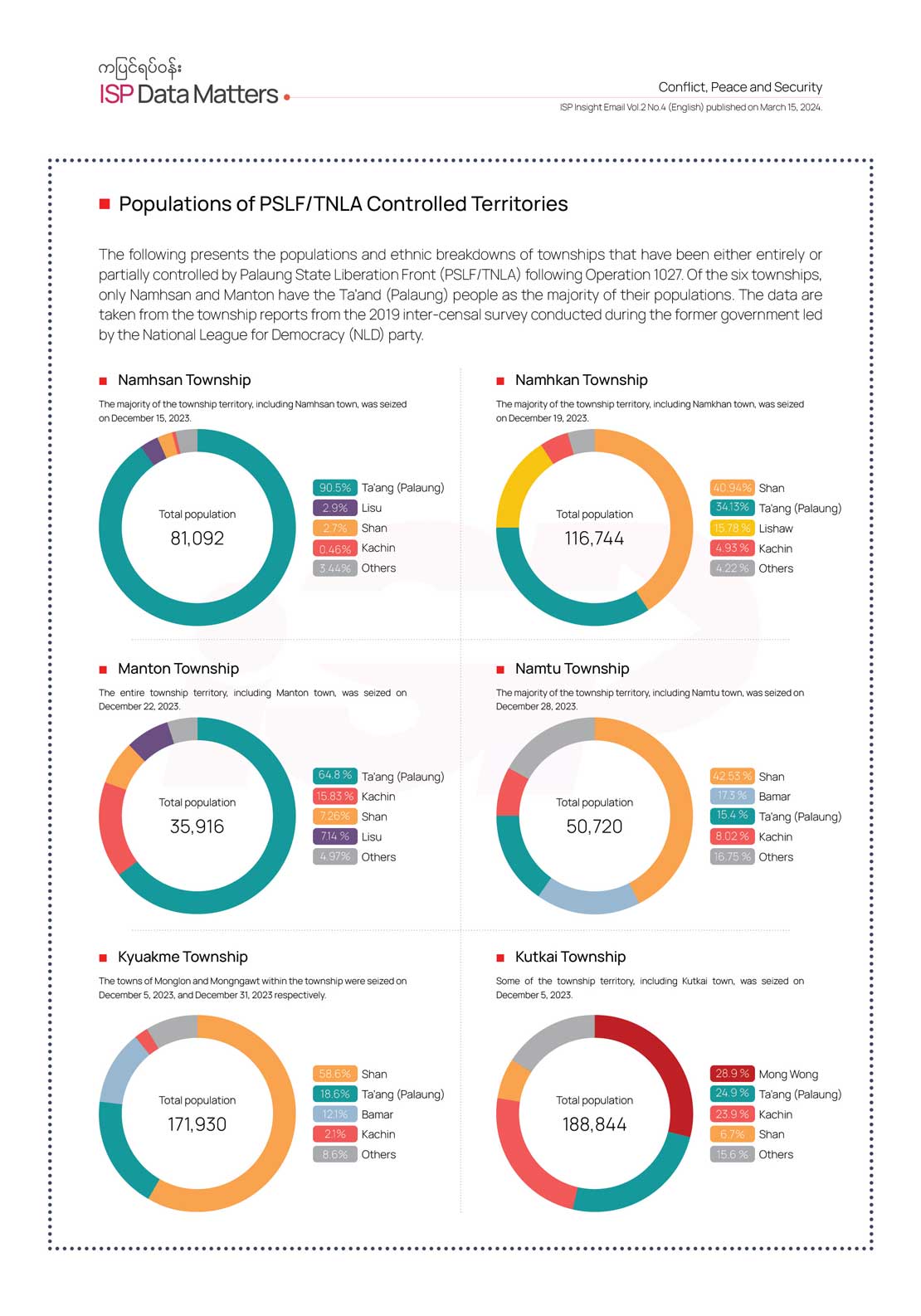
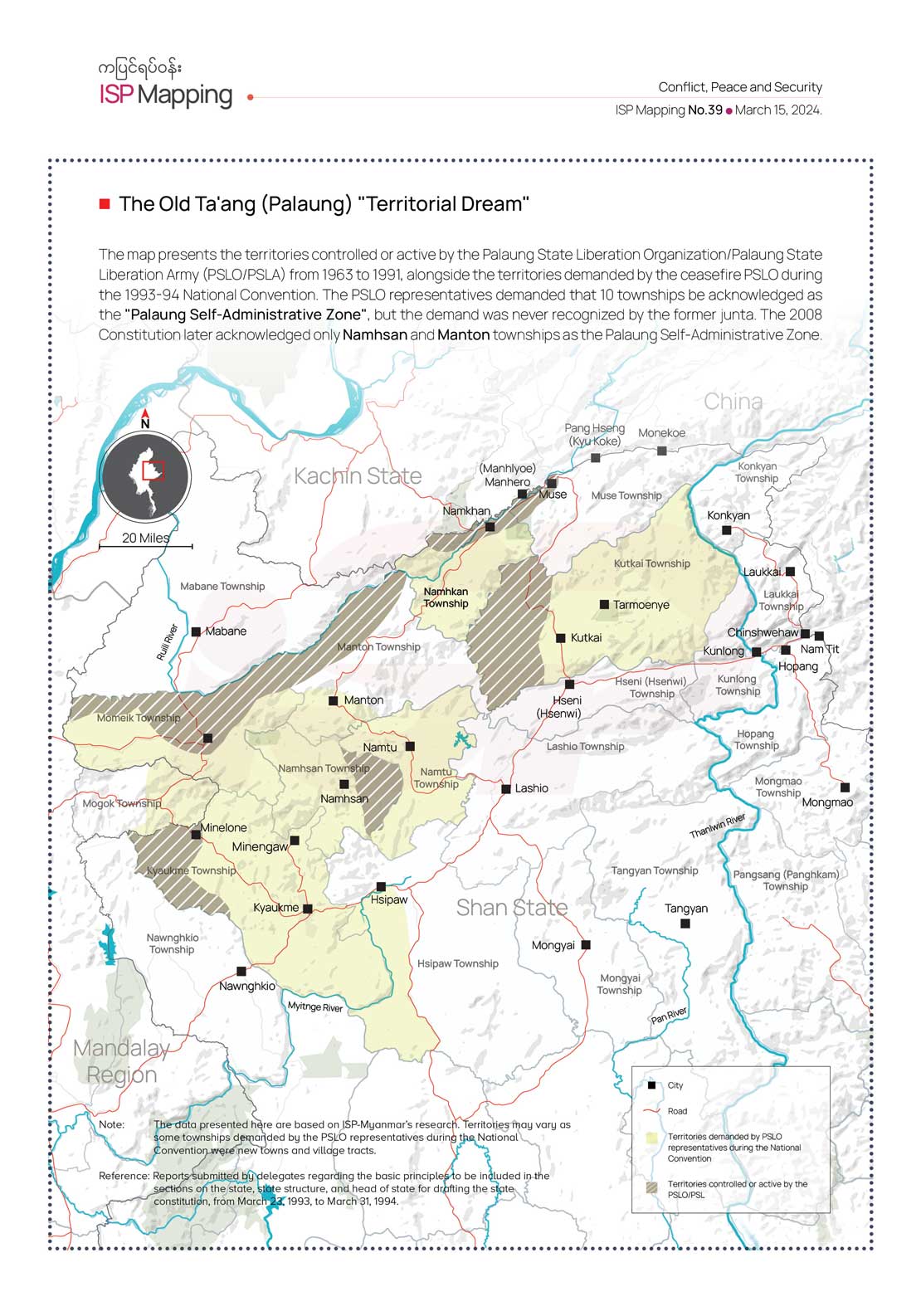
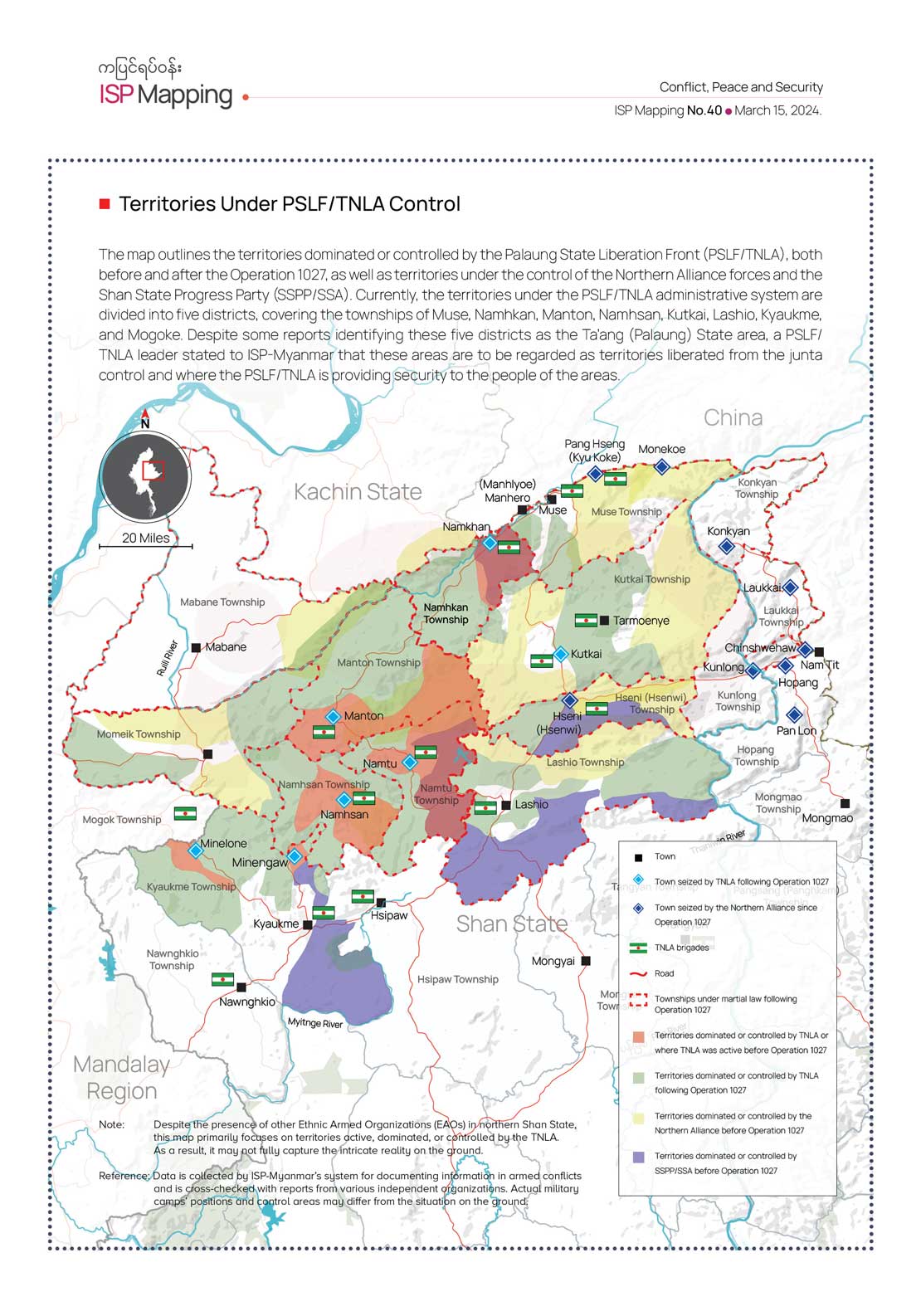
Amidst the sensitive and contentious issues, the younger generation of leaders recognize the significance of the institutions through their own experiences. In such a scenario, it becomes imperative not to lose sight of the objectives to establish a free and inclusive society amidst concerns of territorial ambitions. Implementing a non-discriminatory, inclusive, and equitable administrative policy toward all ethnic groups is crucial. Additionally, prioritizing a free judiciary system, encouraging the involvement of women and youth in critical positions, and fostering the active role of civil society are equally important.
Meanwhile, the SAC announced martial law upon PSLF/TNLA-seized towns such as Namhsan, Manton, and Namtu on March 5, 2024, indicating that it intends to recapture these cities when the time is right. The ramifications of Operation 1027 brought humiliation to the SAC, with the loss of control over the entire Kokang region and a retreat of the entire Regional Operation Command (ROC). The TNLA’s territorial seizure of seven cities included significant trade routes, mining ventures like the Bawdwin mine in Namtu, and tea factories. Since February, the TNLA has reportedly gained control over the Bawdwin mine, allowing it to operate. The “Haigeng Agreement” brokered by China has caused a ceasefire in northern Shan State, but the interpretation of the terms could differ among the signatories. Announcing martial law in these fragile situations could tip the two sides back into conflict again in TNLA-controlled towns.
Nonetheless, the Ta’ang (Palaung) young and mid-aged leaders, just like Ngattapa Min in history, have witnessed some success in their pursuit of territorial aspirations by grasping opportunities they have carved out for themselves. Yet, challenges persist in achieving harmonious and cohesive socio-economic and political development in the Ta’ang region and the future federal union.
SPOTLIGHTS
The “Spotlights” section aims to provide a succinct overview of recent noteworthy developments. Three compelling issues from the past two weeks will be discussed.
Border Bargain: SAC-3BHA 30-70 Accord
Chinshwehaw and Muse border gates were reopened four months after their closure on March 11. Reports indicate that the SAC and the 3BHA cooperated to achieve this result. Before the reopening, the 3BHA announced further agreements with the SAC, including recognizing the Myanmar National Truth and Justice Party/Myanmar National Democratic Alliance (MNTJP/MNDAA) as the official government of Kokang Special Region-1. Additionally, the customs revenue division at the Chinshwehaw border gate was set at 70 per cent for the 3BHA and 30 per cent for the SAC. Trade at the Chinshwehaw border gate averages over one and a half million US dollars daily. Meanwhile, details around the customs from the Muse border gate, another significant trade route, remain undisclosed. Daily trade at the Muse border gate exceeds 7.3 million US dollars. The SAC remains tightlipped about the discussions, but the spokesperson, Maj. Gen. Zaw Min Tun announced the SAC’s position was to ensure the stability of the territorial rule of law and to protect the interests of both Myanmar and China. Following Operation 1027, the SAC and 3BHA met four times in total through China’s mediation in Kunming, China. Analysis regarding Operation 1027 can be read on the ISP-Myanmar website.
KIA’s Strategic Offensive in the North
The Kachin Independence Army (KIA) launched an offensive against and took control of Myanmar Armed Forces (MAF) outposts with allied forces from the AA, Kachin People’s Defense Forces (K-PDF), and other allied groups. This latest offense occurred only 20 miles from the MAF’s Northern Command. The alliance was able to seize strategic Myitkyina-Bhamo roads, strategic mountainous terrain, and over 20 strategic guard camps and outposts in the direction of Laiza, the KIA’s headquarters. The strategic seizures also included Hkaya Bum, control of which could pose a threat to Laiza. Lisu People’s Militia leader Siri Pyan Chi Shwe Min, favored by the SAC, also died during the offensive. He was a political party leader before the coup, later becoming a militia leader. Col. Nawbu, spokesperson of the KIA, confirmed that the allied forces were continuing to target strategic military installations surrounding Laiza. Alongside the ongoing offensive near Laiza, clashes have also been reported in Hpakant and Putao townships.
Myanmar Affairs Raised in Thai Parliament
Earlier this month, a seminar on Myanmar was discussed in the Thai Parliament, with representatives from the NUG, various EAOs, CSOs, Student Union leaders, experts, and media present. The Thai Parliament’s involvement in this matter is notable, especially considering the close relationship between the Thai government and the SAC. Regarding the discussion, the SAC cried foul, sending a letter strongly objecting to the Thai government. Mr. Rangsiman Rome, head of the House Committee on National Security, Border Affairs, National Strategy and National Reform, which was responsible for organizing the event, stated this initiative to be the first step for all stakeholders of Myanmar’s affairs to engage in a dialogue. However, the Deputy Prime Minister and Foreign Minister of Thailand, Mr. Parnpree, who proposed the humanitarian initiative, was absent from the event. The discussion was organized by the opposition Move Forward Party (MFP), and the vice-chair of the Parliament, who is close to the party, made an opening speech. The new Thai government had already been actively engaged in diplomatic relations with neighboring countries. Efforts are currently underway to address the Myanmar issue through humanitarian diplomatic channels. Additionally, plans are in place to establish a humanitarian safe zone at Mae Sot, along the Thai-Myanmar border. Meanwhile, a Thai Navy Rear Admiral embarked on a friendship trip to Yangon accompanied by a warship.

TRENDS TO WATCH
Kyar Phyant Crackdown
If Kyar Phyant operations are suppressed in one location, they relocate to another area and continue their illicit activities.
After Operation 1027 in northern Shan, which was partly aimed at eradicating the online scam syndicates, the term “Kyar Phyant” (originally from the Chinese 诈骗) gained widespread use among the public as it began to emerge as a global threat. According to a report in August 2023 by the United Nations Office on Drugs and Crime (UNODC), these scams are increasing and are orchestrated by organized crime groups. Primarily situated in the Mekong region, including countries like Cambodia, Laos, Myanmar, and other ASEAN nations, these scam syndicates are often linked to human trafficking, forced labor, and even slavery. The UNODC has even coined the term “cyber slavery” to describe cases where individuals are abducted and coerced into committing online crimes. The report estimated that hundreds of thousands to millions of people may be forced to participate in these criminal activities, highlighting the horror of how these schemes extract profits. According to the UNODC report, the profits generated from these scams could range from 7.5 to 12.5 billion US dollars. This amount is equivalent to approximately half of the GDP of some small ASEAN countries, highlighting the global nature of the threat.
2024 can be named “the year of eradicating Kyar Phyant” problem by regional governments, which has become so widespread in Myanmar and neighboring countries. From the opposition National Unity Government (NUG), the Restoration Council of Shan State (RCSS), to the State Administration Council (SAC), all have claimed to eliminate these online scam syndicates. The geographic reach of crackdowns extends from the far northeast to the far south of Myanmar, with repercussions felt along the Thai-Myanmar border from Tachileik to Kawthoung.
In January 2024, Chinese police officers arrived in Nay Pyi Taw. They arrested ten individuals, among them the four Kokang leaders who were closely associated with and shielded by Myanmar Armed Forces (MAF) top leaders. Allegedly, the Beijing Supreme Court later sentenced four of these leaders to death, although no details were reported. UWSA Deputy Commander in Chief Bao Junfeng, aka Tax Ai Chan, the nephew of UWSP Chairman Bao Youxiang, was also detained by the Chinese authorities with similar charges. The Chinese authorities also extended their cross-border search to Monghsu, situated east of the Salween River, in pursuit of two former officers associated with Bao Youxiang. However, Kyar Phyant syndicates that have relocated to Mongyai and Tangyan, where the Shan State Army and United Wa State Army (UWSA) are based, remain unaffected. As per a China Central Television (CCTV) report, out of 689 Thai, Chinese, and Myanmar arrested in Tachileik, almost 500 Chinese nationals have been transferred to Chinese authorities. Additionally, hundreds of online business workers were arrested in Tachileik after surprise raids. But in this region, where multiple armed groups, including the MAF, have been involved in the business, those arrested are low-level workers rather than big fishes.
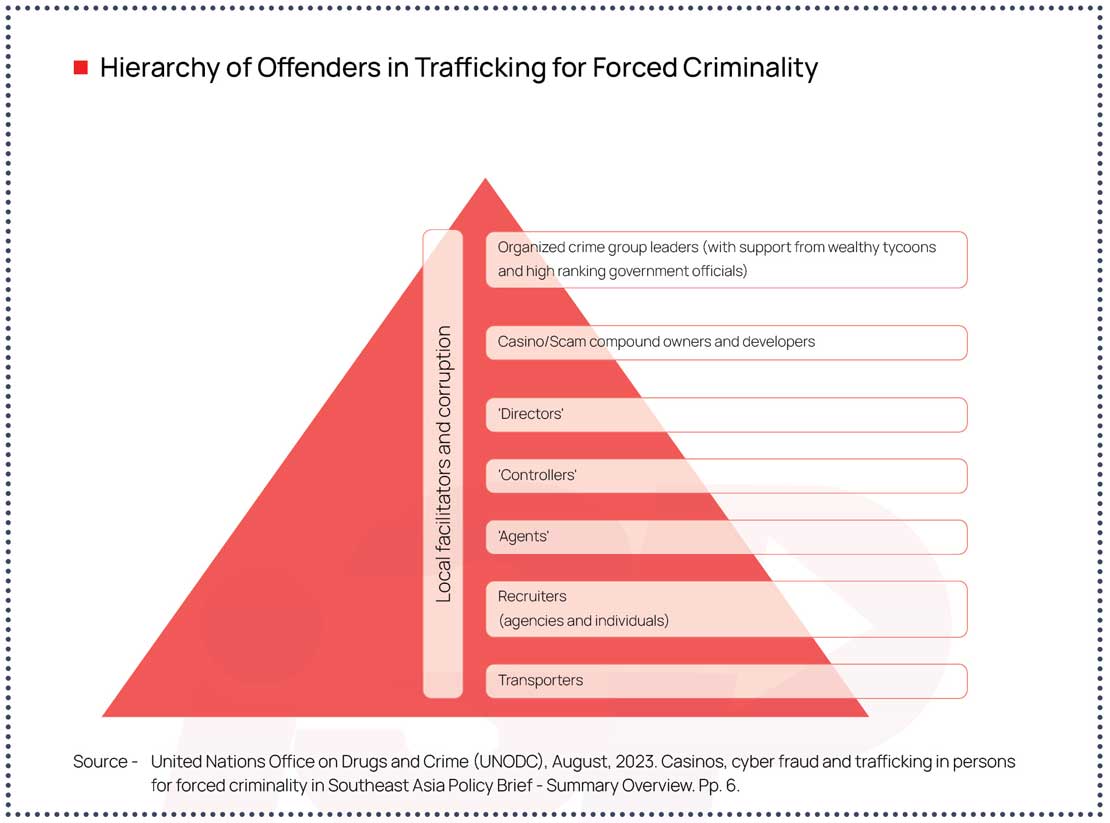
In late 2023, a delegation led by Lt. Gen. Jakkapong Janpengpen, Thailand’s Armed Forces’ Director of Joint Operations, visited Naypyitaw to eliminate Kyar Phyant operations situated along the Myanmar-Thailand border, as well as in Shwe Kokko. SAC Chairman Snr. Gen. Min Aung Hlaing also discussed the matter online with the Royal Thai Chief of Defence Forces, Gen. Songwit Noonpackdee. The Myanmar-Thailand discussion has raised suspicions and tensions between the SAC and the Karen Border Guard Force (BGF), led by Col. Saw Chit Thu. Amidst multiple conflict fronts, the SAC appears to be avoiding a confrontation with Col. Saw Chit Thu, the leader of Myanmar’s most potent border guard force, at least for the time being. Instead of targeting the BGF directly, SAC Chairman Min Aung Hlaing opted to accuse the Karen National Union (KNU) of involvement in online scams and human trafficking. He also issued warnings of potential action against the KNU with the collaboration of neighboring countries.
Next in line is the case of Kyaw Lwin, a prominent business figure in Kawthoung, Tanintharyi, who was issued an arrest warrant by Thailand and the SAC on February 7, 2024, for his alleged involvement in online gambling, tax evasion, and money laundering. Htay Win, aka Naung Paing, younger brother of Kyaw Lwin, died at the interrogation center of the SAC after being captured. Currently, Thai police arrested Kyaw Lwin’s wife and his close staff member, and Kyaw Lwin is still in hiding. Kyaw Lwin, the owner of a five-star hotel on Thahtay Kyun Island (adjacent to Ranong of Thailand), had integrated legal gambling operations within the premises. However, following a raid by a Thai special investigation team on February 1, 2024, the hotel, which employed over 1,500 individuals, has been shut down. According to reports from SAC newspapers, following the launch of Operation 1027 in northern Shan State, a total of 52,820 foreign nationals from China, Vietnam, Thailand, India, and Indonesia were evacuated or otherwise transferred across Myanmar’s borders, with 50,772 of them being Chinese nationals. According to the UNODC report, some victims are coerced into participating in these activities against their will, highlighting the importance of supporting those who are victimized by such crimes in line with human rights principles. Distinguishing between criminals and victims is a challenge in such situations.
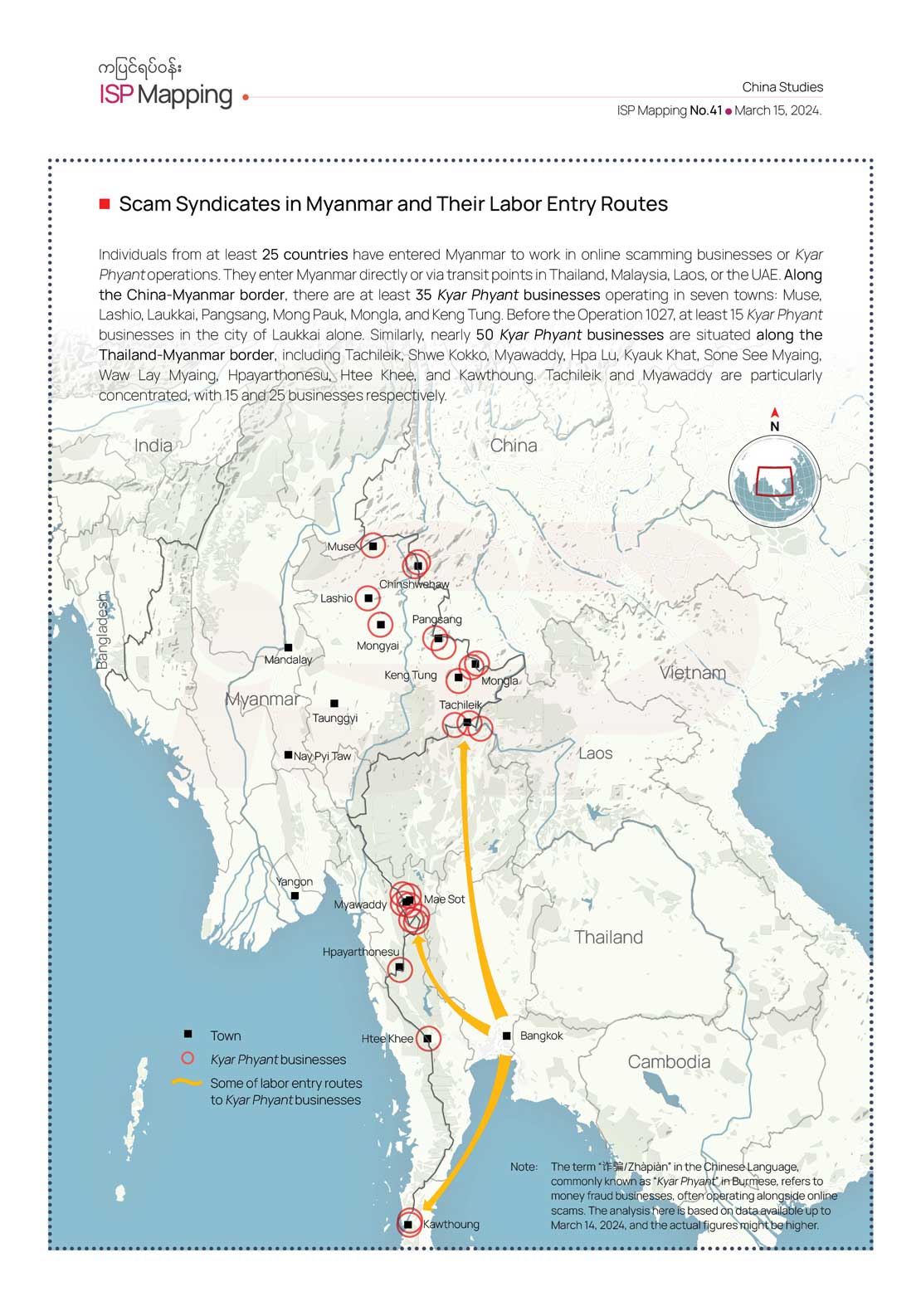
Despite the ongoing efforts to arrest Kyar Phyant operations throughout Myanmar, there remains uncertainty regarding the methods and procedures involved in the arrest and prosecution of Chinese nationals who are leaders of Kyar Phyant gangs. The case of Mr. She Zhijiang, formerly a Chinese citizen, highlights the apparent reluctance or delay on the part of the Chinese government to intervene or provide clarification despite his arrest by Thai authorities more than a year ago. Born in Yunnan Province, She Zhijiang has been involved in the gambling industry across various Southeast Asian countries, including Cambodia, the Philippines, and Myanmar, and involved in the BRI investments. If other Kyar Phyant gang leaders like She remain at large without facing arrest, or if their trials proceed without significant consequences, then the eradication of Kyar Phyant will remain far from complete. Based on the experiences of the Philippines and Indonesia, if Kyar Phyant operations are suppressed in one location, they relocate to another area and continue their illicit activities. Myanmar, Laos, and Cambodia have not reached a conclusive fight againts Kyar Phyant operations. Subsequently, it is imperative to closely monitor the emergence of new bases in border regions and areas lacking a stable rule of law.
WHAT ISP IS READING
China’s Evolving Foreign Policy
It is necessary to better understand China’s constantly evolving foreign policy as a superpower with thousands of years of history and a rich population.
Since Operation 1027, China has assumed a more significant role in mediating the Myanmar conflict. Previously, Myanmar’s peace process was primarily led by Myanmar nationals, claimed limiting to international involvement. However, China’s mediation efforts are now being acknowledged and accepted. Foreign Minister Wang Yi has emphasized China’s commitment to addressing the issue as a matter of importance. Given China’s increased role in Myanmar, it is necessary to better understand China’s constantly evolving foreign policy.
At a press conference on March 7, Foreign Minister Wang Yi highlighted China’s prioritization in addressing three international hot spots: Saudi Arabia-Iran relations, Iran-Pakistan relations, and the Myanmar situation. He stated that China, as a permanent member of the United Nations Security Council, has participated responsibly by intervening in the Myanmar conflict. Wang Yi also stated that wisdom drawn from Chinese culture would help China in finding solutions with Chinese characteristics to heated issues. Some though have opposed his statement in regards to the Myanmar issue.
Wang Yi further emphasized that China, as a large country with thousands of years of history and a rich population, cannot practice its foreign policy with expediency. He highlighted the importance of implementing a stable and strong foreign policy. Looking back at China’s foreign policy in particular, the principles adopted by the 20th National Congress of the Communist Party of China are crucial. On December 28, 2023, the Central Conference on Work Relating to Foreign Affairs of the Central Committee of the Communist Party of China was held. Implementation of the Guiding Principles of the Central Conference on Work Relating to Foreign Affairs comprises ten points, four guiding principles and six imperatives. Three of the four guiding principles are most important to China’s foreign policy towards the Myanmar issue. Firstly, China’s foreign policy is based on President Xi Jinping’s Thought on Diplomacy. Secondly, it is rooted in leveraging China’s unique strengths to cultivate the image of a major country capable of accommodating all forces, characterized by being confident, self-reliant, open, and inclusive. Thirdly, to build a community with a shared future for mankind.
In addition, China’s provinces must adhere to the central principles and implement them accordingly, while self-administrative regions can independently manage some flexible aspects of foreign relations. However, the central policy binds them and cannot override them. In addition, China’s Global Development Initiative, Global Security Initiative, and Global Civilization Initiative are also to be implemented through applied Chinese foreign policy.
Foreign Minister Wang Yi’s press conference speech prioritized the ‘Four Commitments’ of China in solving international conflicts. The first commitment is to not interfere in the internal affairs of other states reiterating China’s respect for sovereignty and territorial integrity in line with the United Nations’ charter. The second commitment is to prioritize political settlements in disputes, not to rely on sanctions obsessively, but rather to advance dialogue and consultation with utmost patience to find a common ground that accommodates the needs of all sides. The third commitment is to objectivity and impartiality, to not practice one-sided favoritism and to seek common geopolitical interests in solving issues for the betterment of the world. The fourth commitment prioritizes addressing conflicts’ symptoms and root causes, aiming to de-escalate tensions and swiftly prevent any further spread. It emphasizes systematic and logical analyses of root causes and employs multi-strategic approaches to resolve them effectively.
As a superpower and neighboring country, China has a deep historical relationship with Myanmar. Understanding China’s foreign policy is crucial for interpreting its involvement in Myanmar’s affairs. When China intervened in Myanmar in an attempt to resolve the northern Shan State conflicts, did China follow the basic principles it has set out for itself? It would seem to be a point of discussion for readers to decide whether China has acted according to its own principles. Readers might want to take it with a grain of salt.
1Individuals who become kings without royal lineage are regarded as “Ngattapa Min.” Historians regard Maung Shin Ngae from the Srikhetra Dynasty (B.C.98) as “Ngattapa Min,” as he became a king without being an offspring of the Dwuttabaung royal family. In Myanmar’s history, Kyansittha (Hti-Hlaing Min) of the Bagan Dynasty, Raza Dipadi (Dhammazedi Min) (1472-1492) of the Hongsawady dynasty, Byaminediraza (Binnya Dala) (1747-1757) of the Restored Hongsawady Kingdom, and Alaungpaya (Aung Zeya) of the Konbaung Dynasty are examples of such rulers.
2This incident dates back to October 2000 in Monekoe, Hay Moe Lone, where a power struggle unfolded between Mong Sala, the leader of the Mongko Defence Army (MDA) – a splinter group from the MNDAA, and Li Nimen. The Myanmar Armed Forces intervened, resulting in the arrest of Mong Sala and the death of Li Nimen, along with hundreds of his troops as well as the end of the MDA. Maj. Gen. Myint Hlaing was then a 16th Military Operation Command (MOC-16) commander who managed the Kokang internal conflict.

To receive ISP Insight Emails in your inbox, subscribe at this link.

